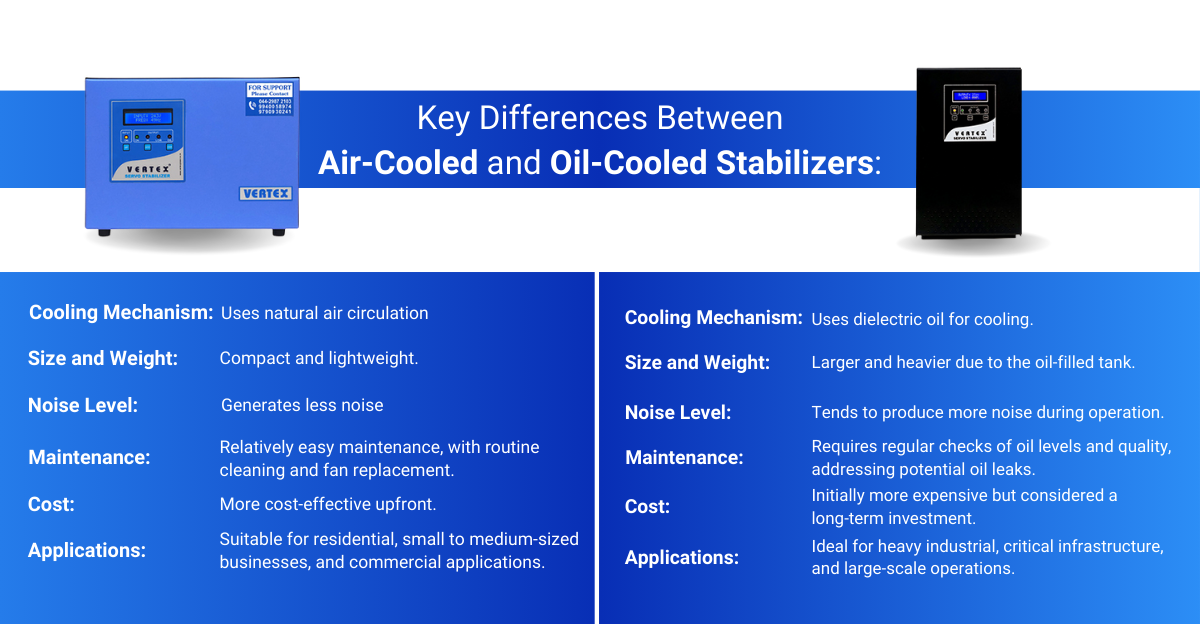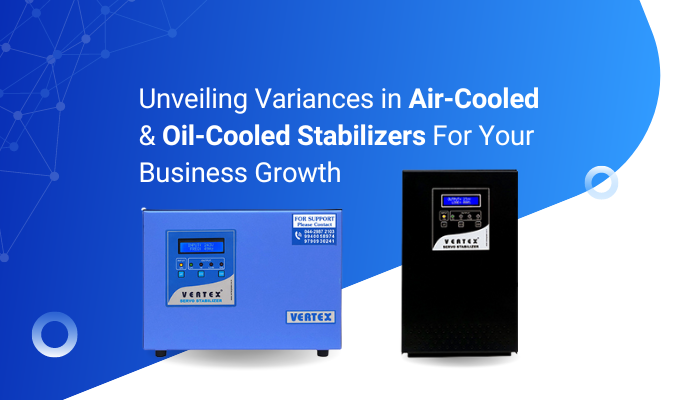To keep high end electronic equipment manufacturers to run as per the manufacturer’s specification , it’s essential to maintain a stable voltage.
Voltage fluctuations in areas with sensitive devices can result in significant damage, data loss, and operational interruptions.
To tackle these problems, voltage stabilizers are employed, with two popular variants being air-cooled stabilizers and oil-cooled stabilizers.
Here we’ll simplify the distinctions between air-cooled and oil-cooled stabilizers, making it easier to choose the right one for your specific needs.
Once you get cleared of what to choose then don’t forget to buy the quality servo voltage stabilizer in india and never fear that your device will be damaged.
Air-Cooled Stabilizers:
Air-cooled stabilizers are a type of voltage stabilizer designed to regulate and stabilize voltage levels in electrical systems. They are widely used in various applications due to their simplicity and effectiveness.
Let’s examine the key features and characteristics of air-cooled stabilizers:
Cooling Mechanism:
- Air cooled servo voltage stabilizer utilize natural air circulation to dissipate heat generated during operations. They are equipped with cooling fans and heat sinks that help maintain a safe operating temperature.
Size and Weight:
- Air-cooled stabilizers are generally compact and lightweight compared to their oil-cooled counterparts. This makes them suitable for installations where space is limited.
Here are the example of few places Air Cooled Servo Voltage Stabilizers can be used :
- Residential Areas: Home & Apartments
- Commercial Establishments: Offices & Companies
- Industrial Units: Large Manufacturing Companies
- Educational Institutions: Schools,Colleges & UniversitiesHospitals and Healthcare Facilities
Maintenance:
- Air-cooled stabilizers are relatively easy to maintain, requiring routine cleaning of the cooling components and fan replacement as needed.
Cost:
- These stabilizers are typically more cost-effective compared to oil-cooled stabilizers, making them a budget-friendly choice for many applications.Contact us to know current market prices of air-cooled Stabilizers.
For Air cooled stabilizers the Limitation is : 200KVA Do you know why?
The limitation of 200KVA for air-cooled stabilizers is attributed to thermal constraints. Air-cooling relies on natural air circulation for heat dissipation. As the capacity increases beyond 200KVA, the heat generated becomes challenging to dissipate effectively.
Larger capacities generate more heat, and air-cooling may struggle to maintain optimal operating temperatures, impacting efficiency and overall performance.
To handle higher loads, liquid-cooled systems or alternative cooling methods are often employed, ensuring stability and longevity in voltage stabilization systems beyond the 200KVA threshold.
Applications of Air-Cooled Stabilizers:
Air-cooled stabilizers find applications in a wide range of settings, including:
- Residential buildings
- Small to medium-sized businesses
- Data centres
- Laboratories
- Telecommunication facilities
- Commercial establishments
- CNC machines
- Textile machines
- Spinning mills
- Cold storage units
- Food processing
Oil-Cooled Stabilizers:
Oil-cooled stabilizers, on the other hand, offer a different approach to voltage stabilization. They are known for their robustness and ability to handle heavy loads and extreme conditions. Here are the distinctive features of oil-cooled stabilizers:
Cooling Mechanism:
- Oil-cooled stabilizers use a specialized dielectric oil (such as transformer oil) as a cooling medium to dissipate heat generated during operation. This oil absorbs and transfers heat away from the stabilizer components.
- No replacement of oil
Size and Weight:
- Oil-cooled stabilizers are larger and heavier compared to air-cooled ones due to the presence of the oil-filled tank.
Here are some example places where oil cooled stabiliser can be used :
- Heavy Industries: large manufacturing plants
- Mining Operations: Mining sites
- Power Generation Plants
- Steel and Metal Processing Units
- Chemical Processing Plants
Maintenance:
- Oil-cooled stabilizers require regular checks and maintenance, including monitoring oil levels and quality, as well as addressing potential oil leaks.
- Low maintenance and high reliable
Cost:
- Oil-cooled stabilizers are generally more expensive upfront compared to air-cooled stabilizers. However, they are a long-term investment due to their durability and ability to handle heavy loads.
For Oil cooled stabilizers the Limitation is : 2000KVA Do you know why?
The limitation of 2000KVA for oil-cooled stabilizers stems from efficient cooling and thermal management. Oil-cooling systems excel in dissipating heat generated by large-capacity stabilizers. As the capacity increases, so does the heat produced during voltage stabilization. Oil-cooling, with its superior heat dissipation properties, can effectively manage larger capacities, ensuring optimal operating temperatures and system efficiency. Beyond 2000KVA, alternative cooling methods or more sophisticated cooling systems may be required to handle the increased heat generation. This limitation ensures that the stabilizer operates reliably, maintaining stable voltage levels while preventing overheating issues associated with excessive capacities.
Applications of Oil-Cooled Stabilizers:
Oil-cooled stabilizers are preferred in scenarios where robust voltage stabilization is required, such as:
- Heavy industrial plants
- Manufacturing units
- Large data centres
- Hospitals
- Critical infrastructure facilities
- Mining operations
Key Differences Between Air-Cooled and Oil-Cooled Stabilizers:

Advantages and Disadvantages:
Now, let’s understand deeper into the advantages and disadvantages of each type of stabilizer to help you make an informed choice:
Advantages of Air-Cooled Stabilizers:
- Cost-effective solution for smaller applications.
- Compact and easy to install in limited spaces.
- Minimal maintenance requirements.
- Quieter operation, suitable for noise-sensitive environments.
- Ideal for residential and small to medium-sized commercial settings.
Disadvantages of Air-Cooled Stabilizers:
- Limited capacity and suitability for heavy loads.
- May not handle extreme environmental conditions as effectively as oil-cooled stabilizers.
Advantages of Oil-Cooled Stabilizers:
- Robust and durable, capable of handling heavy loads and extreme conditions.
- Provides superior voltage regulation and stability.
- Long-term investment with extended lifespan.
- Suitable for critical infrastructure and heavy industrial applications.
Disadvantages of Oil-Cooled Stabilizers:
- Higher initial cost.
- Larger footprint and weight may require dedicated space for installation.
- Requires regular maintenance to monitor oil levels and address potential leaks.
- Produces more noise during operation.
Both air-cooled and oil-cooled stabilizers serve the critical function of maintaining voltage stability, but they cater to different applications and come with their own set of advantages and disadvantages.
The choice between the two depends on the specific requirements of your electrical system, including load capacity, environmental conditions, and budget constraints.
It’s essential to assess your needs carefully and consult with a reputable supplier or expert to make an informed decision that ensures the reliability and longevity of your electrical equipment.
Where to buy quality air cooled or oil cooled stabilizers?
When it comes to purchasing a servo stabilizer, Vertex Company stands out as a trusted and reputable supplier.
With their expertise and commitment to quality, Vertex is the ideal choice for ensuring your voltage stabilization needs are met efficiently and effectively.


